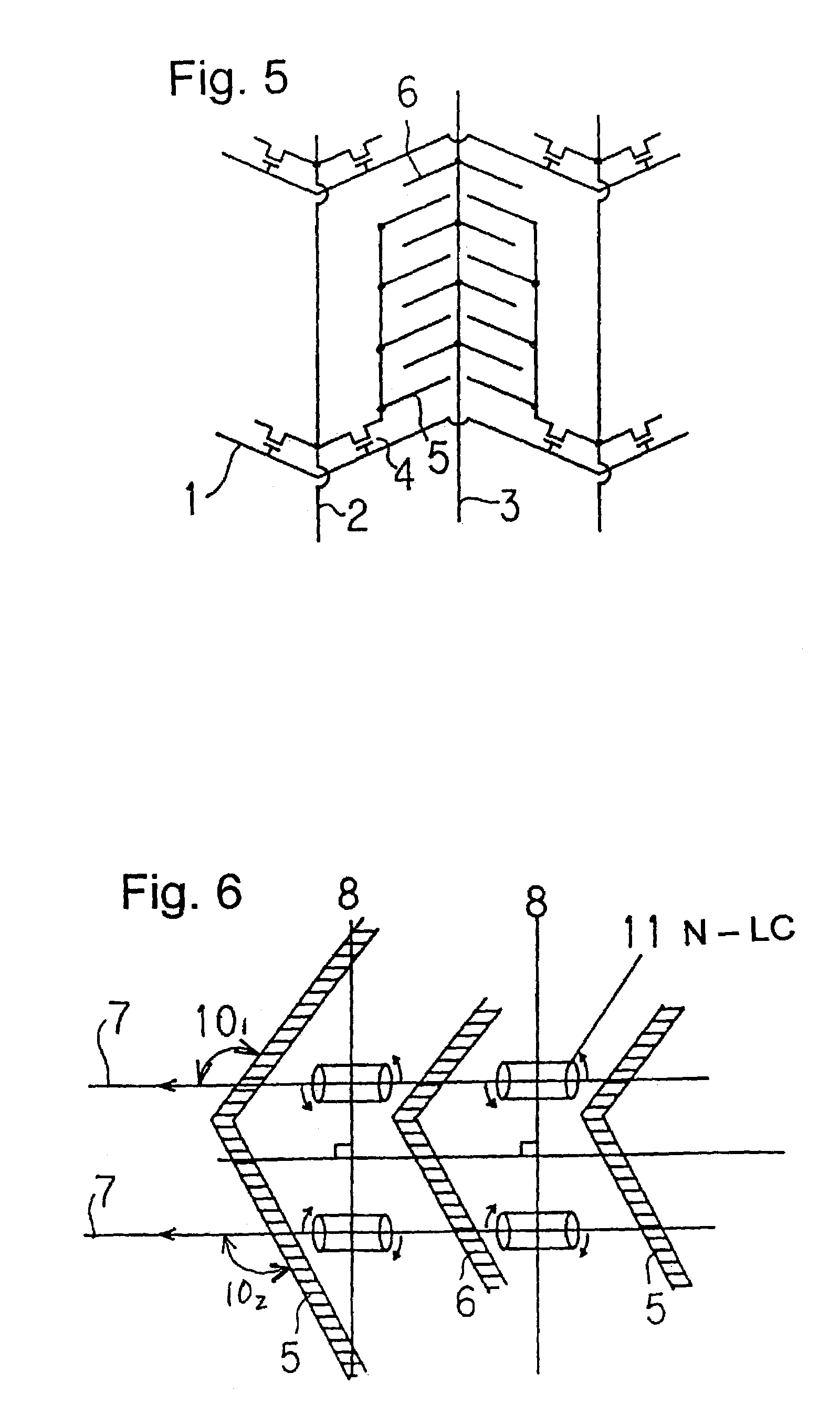Liquid crystal display device comprising pixel and common electrodes inclined in first and second directions to form a zigzag shape which is symmetrical relative to alignment direction of liquid crystal
- Summary
- Abstract
- Description
- Claims
- Application Information
AI Technical Summary
Benefits of technology
Problems solved by technology
Method used
Image
Examples
embodiment 1
[0038]FIGS. 3 and 4 are plan views of a unit pixel showing a basic operational principle of the first embodiment of the present invention. In this example, dielectric anisotropy of the liquid crystal molecule is positive. In FIG. 3, numeral 1 designates a scanning line, numeral 2 is a video signal line, numeral 3 is a common line, numeral 4 is a thin film transistor (TFT), numeral 5 is a pixel electrode (liquid crystal drive electrode), and numeral 6 is a common electrode.
[0039]In FIG. 4, numeral 5 designates a pixel electrode (liquid crystal drive electrode), numeral 6 is a common electrode, numeral 7 is a alignment direction of the liquid crystal molecules as well as a polarization axis of a polarizing plate, numeral 8 is a polarization axis of the other polarizing plate, numeral 9 is a liquid crystal molecule of a positive dielectric anisotropy under zero electric field (P-type liquid crystal molecule), and numeral 10 is an angle that is formed by crossing the alignment direction...
embodiment 2
[0041]FIGS. 4 and 5 are plan views of a unit pixel showing a basic operational principle of the second embodiment of the present invention. In this example, dielectric anisotropy of the liquid crystal molecule is positive. As shown in FIGS. 4 and 5, the scanning line 1 and the pixel electrodes 5 and the common electrodes 6 are so configured as to be bent relative to the alignment direction of the P-type liquid crystal. The bent angle 10 can be selected to be an angle with the best display performance as long as the angle is within the range from ±1 to ±30 degrees. As shown in FIG. 7, there is no limit in the number of bent of the electrodes.
embodiment 3
[Embodiment 3]
[0042]FIGS. 3 and 6 are plan views of a unit pixel showing a basic operational principle of the third embodiment of the present invention. In this example, dielectric anisotropy of the liquid crystal molecule is negative. In FIG. 6, numeral 5 designates a pixel electrode (liquid crystal drive electrode), numeral 6 is a common electrode, numeral 7 is an alignment direction of the liquid crystal molecule as well as a polarization axis of a polarizing plate, numeral 8 is a polarization axis of the other polarizing plate, numeral 10 is an angle that is formed by crossing the alignment direction of the N-type liquid crystal molecule and the pixel electrode, and numeral 11 is a liquid crystal molecule of a negative dielectric anisotropy under zero electric field (N-type liquid crystal molecule). As shown in FIGS. 3 and 6, the video signal line 2 and the pixel electrodes 5 and the common electrodes 6 are so configured as to be bent relative to the alignment direction of the N...
PUM
 Login to View More
Login to View More Abstract
Description
Claims
Application Information
 Login to View More
Login to View More - R&D
- Intellectual Property
- Life Sciences
- Materials
- Tech Scout
- Unparalleled Data Quality
- Higher Quality Content
- 60% Fewer Hallucinations
Browse by: Latest US Patents, China's latest patents, Technical Efficacy Thesaurus, Application Domain, Technology Topic, Popular Technical Reports.
© 2025 PatSnap. All rights reserved.Legal|Privacy policy|Modern Slavery Act Transparency Statement|Sitemap|About US| Contact US: help@patsnap.com



